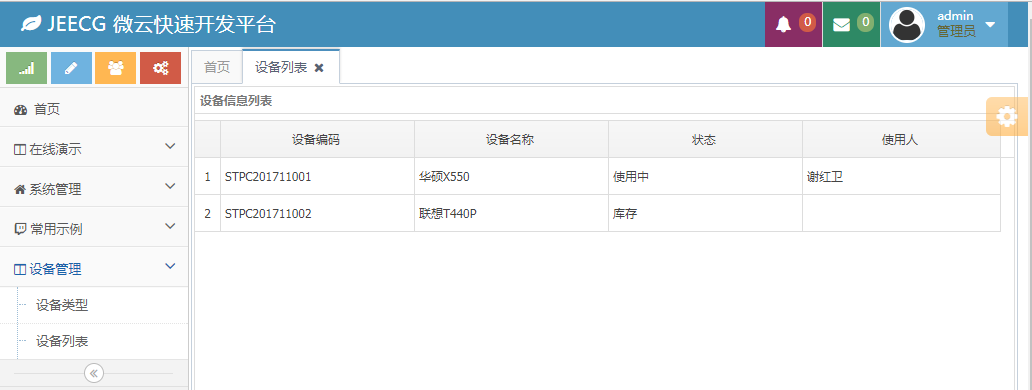一、新建设备表(t_base_device)
SET FOREIGN_KEY_CHECKS=0;
-- ----------------------------
-- Table structure for t_base_device
-- ----------------------------
DROP TABLE IF EXISTS `t_base_device`;
CREATE TABLE `t_base_device` (
`deviceid` int(10) NOT NULL,
`devicecode` varchar(50) DEFAULT NULL,
`devicename` varchar(50) DEFAULT NULL,
`deviceclassno` varchar(10) DEFAULT NULL,
`status` varchar(10) DEFAULT NULL,
`username` varchar(50) DEFAULT NULL,
`userdept` varchar(200) DEFAULT NULL,
PRIMARY KEY (`deviceid`)
) ENGINE=InnoDB DEFAULT CHARSET=utf8;
-- ----------------------------
-- Records of t_base_device
-- ----------------------------
INSERT INTO `t_base_device` VALUES ('10001', 'STPC201711001', '华硕X550', '0101', '使用中', '谢红卫', '软件研发部');
INSERT INTO `t_base_device` VALUES ('10002', 'STPC201711002', '联想T440P', '0101', '库存', null, null);
二、实体类(BaseDevice.java)
package net.xhw.device.entity;
import javax.persistence.Column;
import javax.persistence.Entity;
import javax.persistence.Id;
import javax.persistence.Table;
@SuppressWarnings("serial")
@Entity
@Table(name = "t_base_device")
public class BaseDevice implements java.io.Serializable{
private int deviceid;
private String devicecode;
private String devicename;
private String deviceclassno;
private String status;
private String username;
private String userdept;
@Id
@Column(name = "deviceid", length = 10)
public int getDeviceid() {
return deviceid;
}
@Column(name = "devicecode", length = 50)
public String getDevicecode() {
return devicecode;
}
@Column(name = "devicename", length = 50)
public String getDevicename() {
return devicename;
}
@Column(name = "deviceclassno", length = 10)
public String getDeviceclassno() {
return deviceclassno;
}
@Column(name = "status", length = 10)
public String getStatus() {
return status;
}
@Column(name = "username", length = 50)
public String getUsername() {
return username;
}
@Column(name = "userdept", length = 200)
public String getUserdept() {
return userdept;
}
public void setDeviceid(int deviceid) {
this.deviceid = deviceid;
}
public void setDevicecode(String devicecode) {
this.devicecode = devicecode;
}
public void setDevicename(String devicename) {
this.devicename = devicename;
}
public void setDeviceclassno(String deviceclassno) {
this.deviceclassno = deviceclassno;
}
public void setStatus(String status) {
this.status = status;
}
public void setUsername(String username) {
this.username = username;
}
public void setUserdept(String userdept) {
this.userdept = userdept;
}
}
三、action控制类(DeviceController.java)
package net.xhw.device.ctrl;
import javax.servlet.http.HttpServletRequest;
import javax.servlet.http.HttpServletResponse;
import org.jeecgframework.core.common.controller.BaseController;
import org.jeecgframework.core.common.hibernate.qbc.CriteriaQuery;
import org.jeecgframework.core.common.model.json.DataGrid;
import org.jeecgframework.tag.core.easyui.TagUtil;
import org.jeecgframework.web.system.service.SystemService;
import org.springframework.beans.factory.annotation.Autowired;
import org.springframework.stereotype.Controller;
import org.springframework.web.bind.annotation.RequestMapping;
import org.springframework.web.servlet.ModelAndView;
import net.xhw.device.entity.BaseDevice;
@Controller
@RequestMapping("/deviceController")
public class DeviceController extends BaseController {
private SystemService systemService;
@Autowired
public void setSystemService(SystemService systemService) {
this.systemService = systemService;
}
@RequestMapping(params = "deviceList")
public ModelAndView deviceList(HttpServletRequest request) {
return new ModelAndView("device/deviceList");
}
@RequestMapping(params = "datagrid")
public void datagrid(BaseDevice basedevice, HttpServletRequest request, HttpServletResponse response, DataGrid dataGrid) {
CriteriaQuery cq = new CriteriaQuery(BaseDevice.class, dataGrid);
this.systemService.getDataGridReturn(cq, true);
TagUtil.datagrid(response, dataGrid);
}
}
四、页面文件(deviceList.jsp)
<%@ page language="java" contentType="text/html; charset=UTF-8" pageEncoding="UTF-8"%>
<%@include file="/context/mytags.jsp"%>
<t:base type="jquery,easyui,tools,DatePicker"></t:base>
<t:datagrid name="deviceList" title="设备信息列表" actionUrl="deviceController.do?datagrid"
fit="true" fitColumns="true" idField="deviceid" queryMode="group">
<t:dgCol title="设备ID" field="deviceid" hidden="true"></t:dgCol>
<t:dgCol title="设备编码" field="devicecode" query="false" width="100"></t:dgCol>
<t:dgCol title="设备名称" field="devicename" query="false" width="100"></t:dgCol>
<t:dgCol title="状态" field="status" query="false" width="100"></t:dgCol>
<t:dgCol title="使用人" field="username" query="false" width="100"></t:dgCol>
</t:datagrid>
五、修改配置文件
1、修改spring-mvc.xml,添加扫描控制类包
<context:component-scan base-package="org.jeecgframework.web.*,com.jeecg.*,net.xhw.*"> <context:exclude-filter type="annotation" expression="org.springframework.stereotype.Service" /> </context:component-scan>
2、修改spring-mvc-hibernate.xml,添加注解方式配置
<!-- 注解方式配置 --> <property name="packagesToScan"> <list> <value>org.jeecgframework.web.system.pojo.*</value> <value>org.jeecgframework.web.test.entity.*</value>
<value>org.jeecgframework.web.autoform.*</value>
<value>org.jeecgframework.web.cgform.entity.*</value> <value>org.jeecgframework.web.cgreport.entity.*</value> <value>org.jeecgframework.web.cgdynamgraph.entity.*</value> <value>org.jeecgframework.web.graphreport.entity.*</value> <value>org.jeecgframework.web.system.sms.*</value> <value>com.jeecg.*</value> <value>net.xhw.*</value> </list> </property>
六、菜单配置及结果


